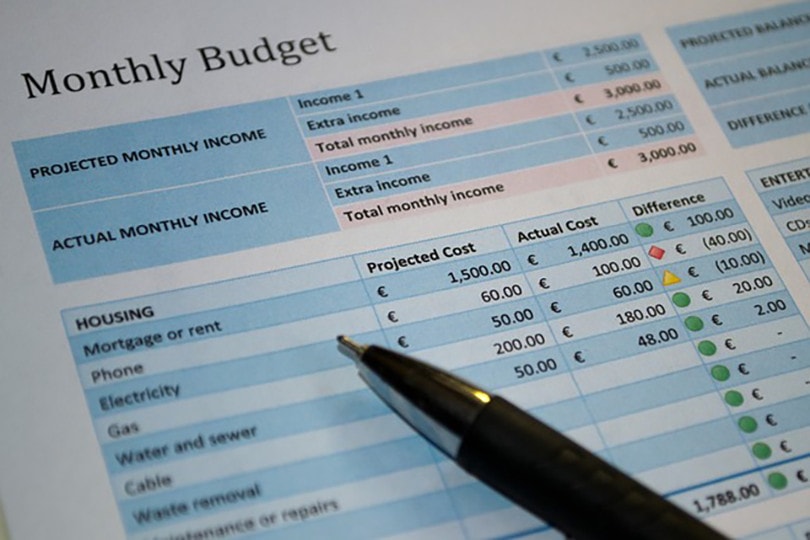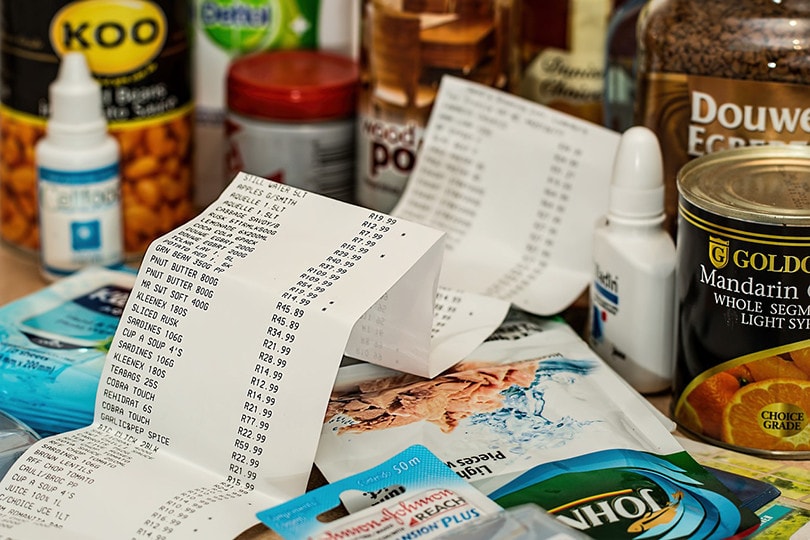How to Save Money on Groceries: 12 Interesting Tips
-
Pete Ortiz
- Last updated:

If you’ve been to a grocery store lately, you’re most likely puzzled by how expensive everything is these days. Food prices keep going up, setting new records. The government is doing its best to fight the soaring prices and to help American households survive the consequences of COVID-19, the war in Ukraine, and the recession.
Still, that’s not nearly enough for many low-income and even middle-class families. The good news is—there are tried-and-true ways to save money on your next trip to Wal-Mart, Costco, or Whole Foods. While you might still have to cut your grocery budget a bit, with the help of the following tips and tricks, it will be much easier to keep food on the table.
The 12 Interesting Tips for Saving Money on Groceries
1. Set a Weekly/Monthly Budget

The first step toward tackling the sky-high food-at-home prices is to come up with a strict budget. It’s usually all the extras that add up to a steep receipt. The average American family spends $400–450 on groceries a month. That means roughly 100 bucks a week. Use that as a guideline, a “threshold” that you shouldn’t go over. It’s going to be a bit tricky to stick to that rule with the ever-rising inflation, but it is an effective solution.
And if you’re not yet ready to cut your grocery budget, you might want to rethink your food-away-from-home expenses. We’re talking about eating out in a restaurant, café, or your favorite coffee shop. Again, it’s all about setting a budget and doing your best to follow it.
2. Always Make a Grocery List
We know how much fun it can be to wheel the cart down the aisles and grab whatever you (or your kids) are in the mood for. However, that’s going to take a heavy toll on your budget this year. That’s why it’s so important to make a detailed list of exactly what you need before setting foot into a mart. A common practice is to only buy stuff that is two-thirds empty.
That applies to milk jars, water canisters, and cracker supplies—you get the idea. This way, you’ll never run out of important grocery products at home. On top of that, when stocked up on the essentials, there will be more time to check out a few stores in search of better prices (we’ll talk about that in more detail in a moment).
3. Follow a Strict Meal Routine
Food diversity is one of those things that make us happy and keep us going. And you can use this to your advantage when tidying up the grocery budget. Take a moment to create a “meal schedule” for every day of the week. Once you do that, it will be much easier to only buy the stuff that goes into those meals, nothing more.
Steak nights on Sundays, lasagna on Mondays, and, let’s say, fried chicken on Tuesdays—that’s how you plan a week properly. Consistency is another thing worth adopting. Try to always go shopping on the same day and at the same store(s). That will help fight the temptation while walking down the aisles because your mind will be focused on getting the stuff that you always buy.

4. Never Shop on an Empty Stomach
This might seem a bit childish, but we tend to buy more food when we go to a store with a “hungry mindset”. When the stomach is empty, your brain is telling you to buy sweets, crackers, and soda. And while snacks do help curb the appetite2, you don’t really need that much (especially if you’re used to cooking at home). The cravings can, indeed, be quite strong.
And they often happen later in the day when you’re tired and desperately need a dopamine hit3 to fix you up. So, make sure to have a bite before leaving the house. You can even do a fun experiment: eat up, but go shopping with a person that’s been hungry for at least a couple of hours. You’ll be amazed by how much “unnecessary” food they’ll put in the cart!
5. Put Coupon Apps to Good Use
If you approach this the right way, coupon apps will help save a substantial amount of money. With that said, they always come with certain requirements. And, sometimes, you’ll end up buying stuff that you don’t even like just to get that cash back. The marketing teams that make these coupons are well aware of how human psychology works and make offers that are hard to resist.
The name of the game here is to only use coupons on products that you do want. There are dozens of coupon apps out there, and while you can download all of them, don’t ever spend your hard-earned money on something silly only because that purchase will be backed by cash back. A quick note: some of these apps can be used to shop at online stores like Amazon (and not only to get food).

6. Keep Track of Current Sales/Discounts
In some ways, sales work the same way as coupons, but they apply to essential foods that most families consume daily. To get the best deals, spend some time checking what different stores have to offer. This tends to be a bit tiresome at times, but sales at the biggest retail stores in the US can be quite significant, especially when they have too much of a certain product and want to get rid of it ASAP.
Sweets after Valentine’s Day, cranberry sauce and potatoes after Christmas, and beef after Independence Day will be A LOT cheaper. Are you a bit old-fashioned? Pay extra attention to retail store ads in your favorite newspapers. This depends on the store (and even the state/city), but most ads are released on Wednesday. Or, just visit the website and see what they have to offer.
7. Don’t Underestimate Customer Rewards Programs
If you’re a regular at a major retail store, they’ll offer you discounts on a wide range of products. You will have to sign up for a rewards program, though. If you skip this part and go on shopping like you normally do, the program won’t kick in. That’s right: the sooner you apply, the better.
These rewards are fully automated, and in the long run, they will, indeed, help save a buck or two on each visit. Just ask one of the salespeople to help get everything set up. They’ll have your program up and running in no time. One last thing: always pay using a credit card with the highest cashback on groceries.

8. Never Shy Away From Store Brands
There’s a common misconception that the quality of retail store brands is lower than the more established brands. However, that’s not really true. In case you didn’t know, store brands are products produced by retail giants, and they’re only available at their stores. Now, while they’re quite cheap, these products are almost just as tasty, nutritious, and healthy.
9. Consider Ordering Online
Grocery lists take seconds to make if you’re shopping online. Just add whatever product(s) you want to the shopping cart in the app, and that’s it. You will, of course, have to pay extra for the delivery. On the bright side, you won’t have to waste time (and gas) to get to a physical store. No waiting in line will be involved, either. When there are no fellow shoppers rushing you in the line, it will be much easier to make conscious purchases.

10. Change Your Eating Habits
Earlier, we talked about how much junk food we buy on an empty stomach. Well, some of that stuff is also pretty expensive. True, organic food isn’t particularly cheap, either. Still, it’s very well possible to find the “sweet spot” between soda and pizza and the more expensive naturally-grown produce. You’ll be surprised by how big of an impact a change in eating habits can have on your wallet.
This will take a learning curve, though. We usually buy junk food when we’re stressed at work or haven’t eaten anything since breakfast. To battle that, get some healthy snacks ready before you leave home. Homecooked meals will always be cheaper and healthier than what you get at McDonald’s, KFC, or any food truck/mobile kitchen.
11. Buy Staple Goods in Bulk
Stuff like flour, beans, grains, and rice last for a long time. You won’t have to worry about any of these products going to waste. More importantly, if you buy this stuff in bulk, it will cost less! The same rules might not apply to vegetables, fruits, or meat, but even snacks and soda are cheaper when bought in large packages.
Going back to the basic staple goods, do check the stickers before paying for them. Chances are, buying in bulk won’t get you anywhere. Always compare the price of a regular package to a bigger one to make sure you’re not getting the same deal or worse.

12. Say No to Prepackaged Products
True, pre-cut vegetables, fruits, and pre-packaged meat are easy to use in the kitchen. Unfortunately, they come at a steep price. So, buy “raw” produce and meat. There’s another pro to this. Instead of having to rely on the integrity of the package, you can pick every single apple, banana, broccoli head, or tomato with your own hands.
Why Did the Food Prices Go Up?
The COVID-19 pandemic had a dramatic impact on world economies. People were making less money, but the prices were not going down. A disrupted supply chain and lack of groceries on shelves at local stores—that’s what pushed the prices up. When things got back to normal, groceries became even more expensive due to an increased demand not only in the US but the entire globe.
And now, two years later, American families are facing yet another global challenge: an ongoing conflict in Eastern Europe (the Ukraine war). Grain shipments still haven’t left Ukraine, and Russia’s refusal to sell fertilizer products to Western countries is making matters worse. And let’s not forget about natural disasters and labor shortages. Another big problem is the EU’s reliance on natural gas from Russia.
Gas today costs more than ever, with California leading the charge (the price for a single gallon is $5.30). It’s much cheaper in Delaware, Alabama, and Oklahoma but still very expensive ($3–4). And the higher the price of gas, the more transport companies have to charge retail stores around the country. As a result, they have no choice but to kick prices up.

How Is the Current Administration Handling This?
So, what is being done right now to strengthen food supply chains and lower the cost of food and gas? Earlier, in May, the government cut costs for local farmers to help them get back on their feet. The disturbingly high food prices across the country have also forced the administration to allocate $2.1 trillion to tame inflation.
Sadly, the actions taken by the administration are not having the effect the average American family expects. The president himself said in June that there’s very little his administration can do to curb the skyrocketing prices of food, gas, rent, and everything else in between.

How Much Do US Households Spend on Groceries?
According to the Bureau of Labor Statistics, we spend $410 a month on food at home, which sums up to $4.9K a year. Considering that the median household income in America is $67K, that’s almost 8%. The spending differs depending on the state, of course. For example, groceries in Hawaii cost 70% more than the national average. In contrast, folks over in Oklahoma have to pay less than anywhere else in the country.
Mississippi, Georgia, and Michigan are also quite affordable. So, if that’s an option for you right now, moving to a different state could help stabilize your budget. But, that only applies if you live in one of the most expensive states and are willing to commit to this.
Conclusion
Along with the rent and the bills, food is not something that you necessarily can (or should) cut the budget on. However, with the coronavirus, supply shortages, and high gas prices, that’s where the US economy is at right now. And the recession is going to make matters even worse. Thankfully, as we learned today, there is a way to keep your monthly grocery expenses low.
Use everything that we talked about today as a guide on how to save money on food. Try to save as much as you can without compromising on the quality of the food, keep your eyes open for discounts and specials, and stay safe! No matter how challenging things might seem right now, always hope for the best!
- GasBuddy – Average Regular Gas Price Comparison by State
- Statista – Share of gas supply from Russia in Europe in 2021
- Politico – Biden’s never-ending inflation nightmare
- CNN – Biden says there’s nothing he can do
- Wikipedia – 2022 Russian invasion of Ukraine
- President Biden Announces New Actions to Address Putin’s Price Hike
- Biden administration announces $2.1 billion to strengthen food system
- Top 10 Most & Least Expensive States for Grocery Shopping in the US
- S. inflation skyrockets to 9.1%, once again exceeding forecasts
- Food Inflation in the United States (1968-2022)
- Bureau Of Labor Statistics – Consumer Expenditures 2020
- BLS – Consumer Price Index News Release
- Income and Poverty in the United States: 2020
- Most Expensive States To Live in 2022
- How Food Addiction Works (and What to Do About It)
- These 5 tips can help you save money on groceries as food prices soar
- USNews – How Much Should I Spend on Groceries?
- 12+ Ways To Save Money On Groceries
- Harvard T.H. Chan – The Science of Snacking
Featured Image Credit: Prostock-studio, Shutterstock
Contents


